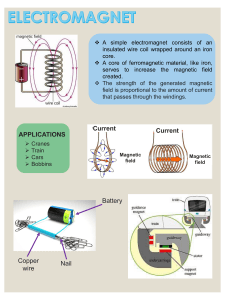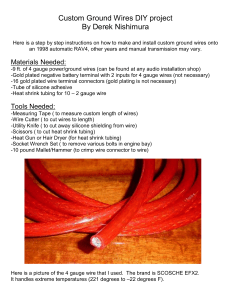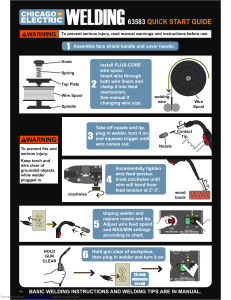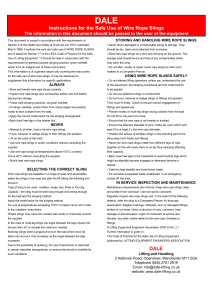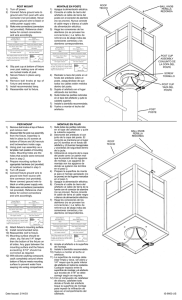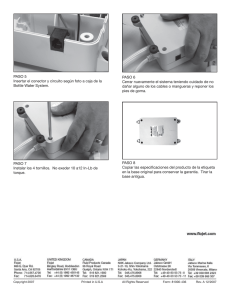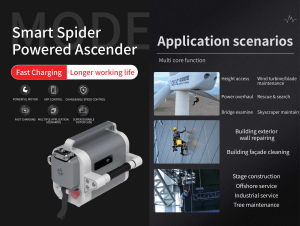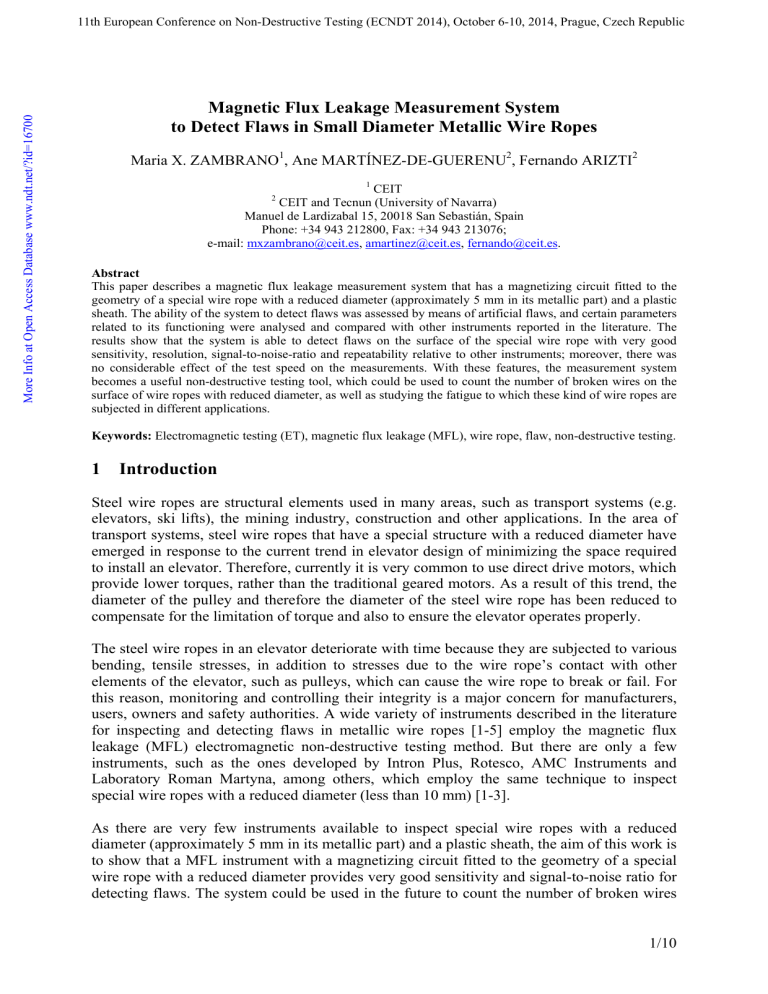
More Info at Open Access Database www.ndt.net/?id=16700 11th European Conference on Non-Destructive Testing (ECNDT 2014), October 6-10, 2014, Prague, Czech Republic Magnetic Flux Leakage Measurement System to Detect Flaws in Small Diameter Metallic Wire Ropes Maria X. ZAMBRANO1, Ane MARTÍNEZ-DE-GUERENU2, Fernando ARIZTI2 1 CEIT CEIT and Tecnun (University of Navarra) Manuel de Lardizabal 15, 20018 San Sebastián, Spain Phone: +34 943 212800, Fax: +34 943 213076; e-mail: [email protected], [email protected], [email protected]. 2 Abstract This paper describes a magnetic flux leakage measurement system that has a magnetizing circuit fitted to the geometry of a special wire rope with a reduced diameter (approximately 5 mm in its metallic part) and a plastic sheath. The ability of the system to detect flaws was assessed by means of artificial flaws, and certain parameters related to its functioning were analysed and compared with other instruments reported in the literature. The results show that the system is able to detect flaws on the surface of the special wire rope with very good sensitivity, resolution, signal-to-noise-ratio and repeatability relative to other instruments; moreover, there was no considerable effect of the test speed on the measurements. With these features, the measurement system becomes a useful non-destructive testing tool, which could be used to count the number of broken wires on the surface of wire ropes with reduced diameter, as well as studying the fatigue to which these kind of wire ropes are subjected in different applications. Keywords: Electromagnetic testing (ET), magnetic flux leakage (MFL), wire rope, flaw, non-destructive testing. 1 Introduction Steel wire ropes are structural elements used in many areas, such as transport systems (e.g. elevators, ski lifts), the mining industry, construction and other applications. In the area of transport systems, steel wire ropes that have a special structure with a reduced diameter have emerged in response to the current trend in elevator design of minimizing the space required to install an elevator. Therefore, currently it is very common to use direct drive motors, which provide lower torques, rather than the traditional geared motors. As a result of this trend, the diameter of the pulley and therefore the diameter of the steel wire rope has been reduced to compensate for the limitation of torque and also to ensure the elevator operates properly. The steel wire ropes in an elevator deteriorate with time because they are subjected to various bending, tensile stresses, in addition to stresses due to the wire rope’s contact with other elements of the elevator, such as pulleys, which can cause the wire rope to break or fail. For this reason, monitoring and controlling their integrity is a major concern for manufacturers, users, owners and safety authorities. A wide variety of instruments described in the literature for inspecting and detecting flaws in metallic wire ropes [1-5] employ the magnetic flux leakage (MFL) electromagnetic non-destructive testing method. But there are only a few instruments, such as the ones developed by Intron Plus, Rotesco, AMC Instruments and Laboratory Roman Martyna, among others, which employ the same technique to inspect special wire ropes with a reduced diameter (less than 10 mm) [1-3]. As there are very few instruments available to inspect special wire ropes with a reduced diameter (approximately 5 mm in its metallic part) and a plastic sheath, the aim of this work is to show that a MFL instrument with a magnetizing circuit fitted to the geometry of a special wire rope with a reduced diameter provides very good sensitivity and signal-to-noise ratio for detecting flaws. The system could be used in the future to count the number of broken wires 1/10 on the surface of special wire ropes and to study the fatigue to which these kind of wire ropes are subjected in different applications. The paper is organised as follows: first, the measurement system and the samples used to test it are described, then the ability to detect flaws is assessed, and finally certain parameters (such as sensitivity, resolution, signal-to-noise-ratio and repeatability and the effect of the test speed on the sensitivity) related to its functioning are analysed and compared with other instruments reported in the literature. The measurement system yields better results than do other instruments used to inspect wire ropes with larger diameters. 2 Description of the magnetic flux leakage measurement system This paper describes and analyses a measurement system for inspection of localized faults (LF) by means of the MFL method. The operating principle of the MFL method for detecting flaws in metallic wire ropes is illustrated in Figure 1a. In this method, the wire rope is homogeneously magnetized close to saturation in the longitudinal direction of the steel wire rope. Broken wires, abrasion or corrosion will generate localized discontinuities in the magnetic flux lines through the wire rope [6]. By using magneto resistive sensors located near the surface of the wire rope, changes in the magnetic leakage fields are detected, recorded and analysed to detect broken wires. A schematic representation of the measurement system implemented is shown in Figure 1b. It is composed of a set of powerful permanent magnets, which are supported by cross-shaped metallic blocks. By using a set of yokes, the permanent magnets are joined to create a closed magnetic circuit around the wire rope; further details about the geometry and dimensions of the measurement system can be found in [7]. The measurement system has two groups of magneto resistive sensors, which are used to measure the magnetic leakage fields near the wire rope surface. Each group is formed by four sensors located around the perimeter of the wire rope and separated from each other by a 90º angle. One group is used to measure the longitudinal component of the magnetic field (HL in Figure 2). The sensors in this group will be identified as longitudinal sensors in what follows. The other group is used to measure the radial component of the magnetic field (HR in Figure 2), and they will be identified as radial sensors in what follows. AA003-02 sensors from the manufacturer NVE are used to measure the radial component of the magnetic field. They have a linear response in the range of 2 to 14 Oe, and beyond 20 Oe they saturate. AA005-02 sensors from the same manufacturer are used to measure the (a) (b) Figure 1. (a) Operating principle of the MFL method and (b) sketch of the measurement system 2/10 (a) Figure 2. Direction of the longitudinal (HL) and radial (HR) components of the magnetic leakage fields near the wire rope surface (b) Figure 3. (a) Position of the electrode to machine artificial flaws, and (b) definition of the dimensions longitudinal component of the magnetic field, and they have a linear response in the range of 10 to 70 Oe and saturate beyond 100 Oe. Signals generated by the sensors are amplified and filtered before being acquired. Data acquisition is carried out by means of a USB-6211 data acquisition card (DAQ), which is controlled by an application implemented in LabVIEW software. Finally, the signals are processed with MATLAB software. 3 Samples used to test the measurement system The rope analysed in this study is a stranded steel wire rope covered with a plastic sheath. The nominal diameter of the rope (including the cover) is 6.5 mm, and the nominal diameter of the metallic part is approximately 5 mm. The steel wire rope consists of 6 Seale strands in the outer layer and an independent wire rope core in the inner layer. Several wire rope samples with different features were used in this study, and they are described below: 3.1 Sample 1 Sample 1 is a wire rope without a plastic sheath and with 15 artificial flaws, which were machined via electrical discharge machining (EDM) and with a distance of 170 mm between consecutive flaws. Figure 3a shows the position of the electrode used to machine a generic flaw of size “a” x “b” mm, shown in Figure 3b. The red arrow indicates the direction of penetration, and the red shaded area represents an estimation of the amount of removed material. Flaws with width values (“a”) of 0.8 and 1 mm and depth values (“b”) between 0.3 and 1 mm were machined. 3.2 Sample 2 Sample 2 is a wire rope without a plastic sheath and with 24 artificial flaws, which were machined by using wire EDM and with a distance of 170 mm between consecutive flaws. Flaws with width values (“a”) between 0.25 and 1.5 mm and depth values (“b”) of 0.25 and 0.3 mm were machined. 3.3 Sample 3 Sample 3 is a wire rope with a plastic sheath and 5 artificial flaws, which were machined by using a cutting tool. These flaws were machined with a distance of 1 m between consecutive flaws. It was not possible to control the width and the depth of the flaws made by the cutting tool, but after cutting the number of broken wires were counted and the amount of loss section that these broken wires represent in each flaw was calculated. These values are listed in Table 1. 3/10 Table 1. Features of the artificial flaws machined in sample 3 Number of Percentage of Flaws broken wires loss section (%) 1 17 11.69 2 8 5.51 3 6 4.13 4 8 5.51 5 12 8.27 4 Performance of the measurement system 4.1 Detection of broken wires In order to verify the ability of the measurement system to detect flaws, tests were carried out on sample 1 with flaws machined on the surface. Figure 4a and Figure 4b show the amplitude of the signals of the four longitudinal and the four radial sensors, respectively, obtained in a section of sample 1 containing 9 flaws. It can be seen that all flaws were detected by a pulse in the magnetic signal with at least one of the four longitudinal and the four radial sensors. Large flaws, such as flaw 9 (depth value of 1 mm), were detected by all longitudinal and radial sensors; while the flaws with the smallest sizes, such as flaw 2 (depth value of 0.3 mm), were only detected by the sensors located closer to them, in this case the ones in the 90º angle position. It is important to point out that the flaws were detected by pulses with different amplitude values, which depended both on the size of the flaws and how close they were from each of the sensors. The results show that there is a clear relation between the size of the flaws and the number of sensors that are able to detect the flaws, and there is also a relation between the size and the position of the flaws and the amplitude of the pulses obtained. These results are consistent with those in [4], which simulated wire ropes of a diameter greater than 10 mm. A flaw in a wire rope produces amplitude fluctuations in the longitudinal and radial components of the flux density inside the wire rope, which are reflected in different angular positions around the 0º 0.4 0.2 2 3 4 5 6 7 8 0.5 9 4000 4200 4400 4600 4800 0.5 0 3800 180º 4000 4200 4400 4600 4800 5000 0.2 0 0.4 3 4 5 6 7 8 9 3800 270º -0.5 5000 4000 4200 4400 4600 4800 5000 Output voltage (V) Output voltage (V) 3800 90º 0.2 0.4 2 0 0 0.4 0º 1 1 3800 90º 4000 4200 4400 4600 4800 5000 3800 180º 4000 4200 4400 4600 4800 5000 3800 270º 4000 4200 4400 4600 4800 5000 3800 4000 4200 4400 4600 Wire rope length (mm) 4800 5000 0 -0.5 0.5 0 -0.5 0.5 0 0.2 0 3800 4000 4200 4400 4600 Wire rope length (mm) 4800 5000 -0.5 (a) (b) Figure 4. Magnetic flux leakage field measured by the (a) four longitudinal sensors and (b) four radial sensors, obtained in a section of sample 1 containing flaws 1-9 4/10 wire rope. The maximum fluctuation is produced in the angular position where the flaw is located [4]. As a consequence, it is expected that larger size flaws would be detected by all sensors, while smaller size flaws would only be detected by the sensor located in front of or near the flaw. The quantitative analysis of the performance of the measurement system was carried out based on the signals resulting from the sum of the four longitudinal sensors, which will be identified as VLsum, and from the sum of the signals of the four radial sensors, which will be identified as VRsum (see Figure 5a and Figure 5b). This way the relation between the size and position of the flaw and the amplitude of the pulses obtained is considered in the analysis, and the information provided by all sensors, regardless of what sensor is able to detect each flaw, is taken into account. 4.2 Sensitivity The sensitivity of the measurement system was determined by establishing a threshold value in the signals of the longitudinal and radial sensors, as it has been considered in [8]. Figure 6a and Figure 6b show the amplitude of the longitudinal (VLsum) and radial (VRsum) signals, respectively, when measuring a section of sample 2. On the one hand, it can be seen that flaw 7 is the smallest flaw that produces a pulse with an amplitude value higher than the threshold value in the longitudinal signals (Figure 6a). This flaw has only a broken wire and represents a small section loss of 1.02 %. On the other hand, it can be seen that in the radial signals (Figure 6b) flaw 16 is the smallest flaw that produces a pulse with negative amplitude followed by a pulse with positive amplitude, and both of them have amplitude values that surpass the threshold values. This flaw has only three broken wires, which represent a small section loss of 2.04 %. It should be noted that the diameter of the wire rope inspected with the measurement system, is significantly smaller than the diameter of wire ropes inspected with some instruments 1 VLsum (V) 1 2 3 4 5 6 7 8 9 0.5 0 -0.5 3800 4000 (a) 1.5 1 2 3 4200 4400 Wire rope length (mm) 4 5 6 4600 7 4800 8 5000 9 VRsum (V) 1 0.5 0 -0.5 -1 -1.5 3800 4000 4200 4400 4600 4800 5000 Wire rope length (mm) (b) Figure 5. Signals resulting (a) from the sum of the four longitudinal sensors (VLsum), and (b) from the sum of the four radial sensors (VRsum), in a section of the sample 1 containing the flaws 1 – 9 5/10 0.4 1 0.5 0.2 VRsum (V) VLsum (V) 0.3 0.1 0 0 -0.5 -0.1 6 -0.2 0 7 200 14 8 9 10 11 -1 400 600 800 1000 1400 15 1600 16 17 18 19 1800 2000 2200 2400 Wire rope length (mm) Wire rope length (mm) (b) (a) Figure 6. (a) Longitudinal (VLsum) signal and (b) radial (VRsum) signal, in a section of sample 2 containing 6 flaws reported in the literature. An example of these instruments is the one described in [9, 10], which is able to inspect wire ropes of a diameter of 38 mm with a sensitivity of a flaw of 1 mm in width and 2 mm in depth, which represents a section loss of 5.26 % of the wire rope section. Another example is the instrument described in [11], which is able to inspect wire ropes of 64 mm diameter with a sensitivity of a flaw of a depth of 2 mm, which represents a section loss of 3.12 % of the wire rope section. Therefore, the present measurement system has very good sensitivity in both groups of sensors, which allows the detection of flaws as small as only one broken wire, which represents a low percentage of section loss (1.02 %), in wire ropes with a reduced diameter (approximately 5 mm in its metallic section). 4.3 Resolution In order to quantify the resolution of the measurement system as it has been defined in [9, 10], some tests were carried out with a sample without a plastic sheath and with three flaws of 0.50 mm in width and 0.30 mm in depth. The flaws were machined by using wire EDM, with a distance of 6 mm between consecutive flaws, which placed each flaw in consecutive strands. Figure 7a shows an image of the three flaws, and Figure 7b shows the longitudinal (VLsum) signal obtained for the three flaws, where it is possible to identify three pulses, which correspond to the three flaws. This shows that the measurement system has a resolution of 6 mm for a wire rope with a diameter of approximately 5 mm in the metallic part. 4.4 Signal to noise ratio (SNR) The signal-to-noise ratio (SNR) of the measurement system for detecting flaws was determined by analysing wire rope sections with and without flaws as in [4, 9, 12, 13]. The VLsum (V) 1 12 0.5 3 0 -0.5 680 700 720 740 760 780 Wire rope length (mm) (a) (b) Figure 7. (a) Image of three flaws machined in a sample without plastic sheath, and (b) longitudinal (VLsum) signal obtained for the three flaws 6/10 lay-noise or background noise produced by the geometry of the wire rope was measured in a section of the wire rope without flaws. In the longitudinal (VLsum) and radial (VRsum) signals the lay-noise — identified as (Vn) and (Vn(p-p)) — varies between ± 50 mV and ± 150 mV, respectively. Figure 8a and Figure 8b show, respectively, the longitudinal (VLsum) signal in a section of sample 2 where there are 11 flaws, and the radial (VRsum) signal in a section of sample 1 where there are 10 flaws. Flaws 6, 7, 8, 9, 11, 14 and 15 are the smallest ones in the section of the wire rope shown in Figure 8a. Each one has a broken wire in the wire rope surface, which represents a section loss of 1.02 % (except for flaw 7, which only has a worn wire). These flaws produce pulses with amplitude values between 160 and 300 mV with a mean value (VLp) of 210 mV in the longitudinal (VLsum) signal; thus, the SNR of the longitudinal signal (SNRlong) to detect the smallest flaw in that section is: SNRlong = VLp Vn = 210 mV = 4.38 , SNRlong (dB ) = 20 ⋅ log10 (SNRlong ) = 12.82 dB 50 mV (1) Flaw 12 is the smallest in the section of the wire rope shown in Figure 8b. It has three broken wires that represent a section loss of 2.40 % and produce a peak-to-peak value (VR(p-p)) of 820 mV in the radial (VRsum) signal. Therefore, the SNR of the radial signal (SNRrad) to detect the smallest flaw in that section is: SNRrad = VR ( p − p ) 820 mV = = 2.73 , SNRrad (dB ) = 20 ⋅ log10 (SNRrad ) = 8.73 dB Vn ( p − p ) 300 mV (2) European Standards [14] establish that the amplitude of pulses obtained by means of LF instruments must be at least two times superior to the lay-noise; thus, taking into account this criterion, the measurement system has a proper SNR for detecting flaws. The SNR is in the same range (between 1 and 5) as the instrument described in [10], but it should be noted that 0.8 VLsum (V) 0.6 0.4 0.2 0 -0.2 0 6 7 200 8 9 400 10 600 11 12 13 800 1000 1200 Wire rope length (mm) (a) 14 1400 15 1600 16 1800 2000 1.5 VRsum (V) 1 820 mV 0.5 0 -0.5 -1 -1.5 5000 6 7 5200 5400 8 9 5600 12 13 14 15 5800 6000 6200 Wire rope length (mm) 10 11 6400 6600 6800 7000 (b) Figure 8. (a) Longitudinal (VLsum) signal in a section of sample 2 where the flaws 6 - 16 are located, and (b) radial (VRsum) signal in a section of sample 1 where the flaws 6 - 15 are located 7/10 the measurement system has better sensitivity, as it is capable of detecting a smaller percentage of section loss (1.02 % and 2.04 % against 5.26 % in [10]) in a wire rope with a smaller diameter (approximately 5 mm in the metallic part against 38 mm in [10]). 4.5 Repeatability To verify the degree of consistency and to assess the reliability of the measurements obtained with the system, the repeatability of the measurement system was evaluated with sample 3. This sample was tested six times on the same day, and under the same conditions; the longitudinal (VLsum) and radial (VRsum) signals obtained in all repetitions were compared and the accuracy of the measurement was also assessed. For each flaw in sample 3, the mean value of the amplitude of the pulses produced, the standard deviation (σ) and the σ in percentage with respect to the mean value of the measurements were calculated. Table 2 shows the values of the pulses obtained in the longitudinal (VLsum) and radial (VRsum) signals. According to the size of the flaws analysed (see Table 1), measurements carried out with the longitudinal and the radial sensors with a large number of broken wires may vary up to 8 and 6 %, respectively. 4.6 Effect of test speed on the sensitivity of the measurement system The effect of the test speed on the sensitivity of the measurement system was estimated by measuring the amplitude of the pulses produced by three flaws from sample 2, tested at different speeds between 1 – 3 m/s, with a step of 0.5 m/s. Figure 9a and Figure 9b show the amplitude of the pulses in the longitudinal (VLsum) and radial (VRsum) signals under these conditions. Table 3 shows the values of the pulses in the longitudinal and radial signals respectively, along with the mean value, σ (in volts) and σ (in percentage) with respect to the mean value of the amplitude of the pulses. It can be seen that there is no clear correspondence between the amplitude of the pulses and the test speed. The percentage of variation in the amplitude of the pulses due to changes in the test speed is less than 5 % in both the longitudinal and the radial signals. The results show that the test speed in the range 1 – 3 m/s does not have a significant effect on the magnetic flux leakage measurements. This is due to the magnetoresistive sensors used in the present measurement system, as they provide an absolute measurement of the magnetic field according to changes in the electrical resistance of the material inside them, no matter what the test speed is. The behaviour of these kinds of sensors represents an advantage over instruments with coil sensors, such as the ones described in [3, 9, 10, 15], in which the test speed has a negative effect in that the signal amplitude is reduced with an increase in the test Table 2. Mean value and standard deviation data for the pulses obtained in the longitudinal (VLsum) and radial (VRsum) signals due to the flaws in sample 3 Longitudinal signal Radial signal Flaws Mean value Mean value σ (V) σ (%) σ (V) σ (%) (V) (V) 1 2.15 0.050 2.32 3.03 0.027 0.8 2 1.27 0.035 2.75 1.40 0.050 3.57 3 0.65 0.036 5.35 0.97 0.031 3.19 4 1.03 0.081 7.86 1.01 0.059 5.84 5 1.57 0.097 6.17 2.06 0.112 5.43 8/10 0.8 1.2 VRsum (V) VLsum (V) 0.7 1.4 Flaw 22 Flaw 23 Flaw 24 0.6 0.5 0.4 0 Flaw 22 Flaw 23 Flaw 24 1 0.8 0.6 1 2 3 Test speed (m/s) 0.4 0 4 1 2 3 4 Test speed (m/s) (a) (b) Figure 9. Amplitude of the pulses in the (a) longitudinal (VLsum) signal, and (b) radial (VRsum) signal, in a section of sample 2 where flaws 22 – 24 are located Table 3. Amplitude of the pulses obtained in the longitudinal (VLsum) and radial (VRsum) signals, in a section of sample 2 containing flaws 22 - 24 Pulse amplitude, long. signal (V) Positive pulse amplitude, radial signal (V) Test speed (m/s) Flaw 22 Flaw 23 Flaw 24 Flaw 22 Flaw 23 Flaw 24 1.0 0.489 0.640 0.504 0.575 0.804 0.942 1.5 0.499 0.640 0.496 0.627 0.841 1.005 2.0 0.501 0.646 0.510 0.612 0.844 1.017 2.5 0.524 0.643 0.506 0.615 0.843 1.016 3.0 0.522 0.630 0.504 0.597 0.843 1.020 Mean (V) σ (V) σ (%) 0.507 0.015 2.98 0.640 0.0058 0.90 0.504 0.0053 1.06 0.605 0.019 3.30 0.835 0.017 2.10 1.000 0.032 3.27 speed. Thus, with the measurement system described here it is possible to inspect wire ropes at different test speeds without having to compensate for the amplitude of the signals. 5 Conclusions The results demonstrate that it is possible to detect flaws on the surface of a wire rope with a very small diameter (approximately 5 mm) by means of the magnetic flux leakage testing technique by using the measurement system described in this work. The measurement system´s sensitivity is equivalent to a section loss of 1.02 % and 2.04 % of the wire rope section in the longitudinal and radial signals, respectively, and has a resolution of 6 mm. The repeatability of the measurements varies up to 8 and 6 % in the longitudinal and radial signals. The SNR of the longitudinal and radial signals to detect the smallest flaw is 4.38 and 2.73, respectively; these SNR values are acceptable for detecting flaws according to European Standards. The test speed in the range 1 - 3 m/s has no effect on the measurements. Finally, all the features of the measurement system make it a useful non destructive testing tool, which could be used to count the number of broken wires on the surface of wire ropes with reduced diameter. Moreover, it could be used to study the fatigue to which these kinds of wire ropes are subjected in different applications. 9/10 References 1. M Dohm, 'Evaluation of International and Local Magnetic Rope Testing Instrument Defect Detection Capabilities and Resolution, Particularly in Respect of Low Rotation, MultiLayer Rope Constructions', Safety in Mines Research Advisory Committee, GAP 503, 1999. 2. A Tytko, C Chaplin and I Ridge, 'Wire Rope Non-Destructive Testing (NDT)', Health and Safety Executive, OTO 1999-032, 1999. 3. I Ridge and C Chaplin, 'Wire Rope Non-Destructive Testing - Survey of Instrument Manufacturers', Health and Safety Executive, OTO 2000-064, 2000. 4. A Canova and B Vusini, 'Magnetic Analysis of Non-Destructive Testing Detectors for Ferromagnetic Ropes', COMPEL: The International Journal for Computation and Mathematics in Electrical and Electronic Engineering, Vol 27, pp 869-878, 2008. 5. F Xu, X Wang and H Wu, 'Inspection Method of Cable-Stayed Bridge using Magnetic Flux Leakage Detection: Principle, Sensor Design, and Signal Processing', Journal of Mechanical Science and Technology, Vol 26, pp 661-669, 2012. 6. H Gang, W Hong-yao, C Feng-jun et al., 'Improving SNR of MFL Signal in Flaw Detection of Coal Mine Wire Ropes', 2nd International Congress on Image and Signal Processing CISP'09, pp 1-6, 2009. 7. M X Zambrano, A Martínez-de-Guerenu and F Arizti, 'Development of a Nondestructive System for Inspection of Steel Wire Ropes', 12th Spanish National Conference on NDT, pp 617-626, 2011. 8. A Canova, F Ficili and D Rossi, 'Magneto-Inductive Sensors for Metallic Ropes in Lift Application', Sensors & Transducers Journal, Vol 9, pp 71-81, 2010. 9. C Jomdecha, A Prateepasen and W Methong, 'Coil Sensors for Wire Rope Inspection using Magnetic Flux Leakage Instrument', 2nd International Conference on Control Automation and System (ICCAS 2002), pp 1311-1316, 2002. 10. C Jomdecha and A Prateepasen, 'Design of Modified Electromagnetic Main-Flux for Steel Wire Rope Inspection', NDT&E International, Vol 42, pp 77-83, 2009. 11. W Sharatchandra Singh, B Rao, C Mukhopadhyay and T Jayakumar, 'GMR-Based Magnetic Flux Leakage Technique for Condition Monitoring of Steel Track Rope', Insight Non-Destructive Testing and Condition Monitoring, Vol 53, pp 377-381, 2011. 12. H R Weischedel, 'The Inspection of Wire Ropes in Service: A Critical Review', Materials Evaluation, Vol 43, pp 1592-1605, 1985. 13. H R Weischedel, 'Quantitative in-Service Inspection of Wire Ropes, Applications and Theory', International Advances in Nondestructive Testing, Vol 15, pp 83-118, 1990. 14. 'Safety Requirements for Cableway Installations Designed to Carry Persons - Ropes - Part 8: Magnetic Rope Testing (MRT)', EN 12927-8:2006, 2006. 15. N Sumyong, A Prateepasen and P Kaewtrakulpong, 'Influence of Scanning Velocity and Gap Distance on Magnetic Flux Leakage Measurement', Transactions on Electrical Engineering, Electronics and Communications, Vol 5, pp 118-122, 2007. 10/10
